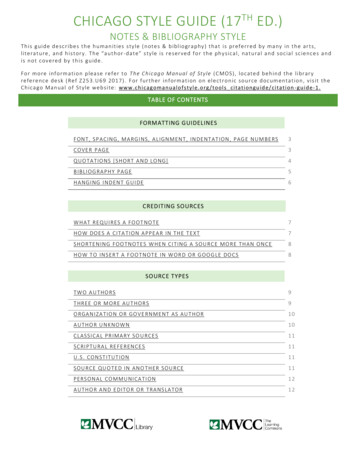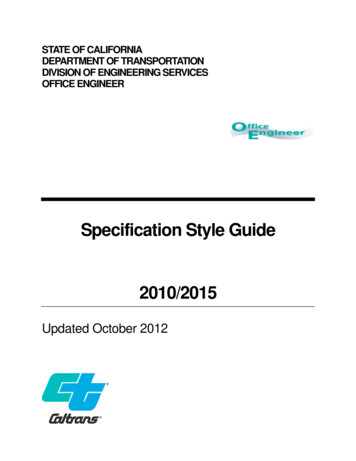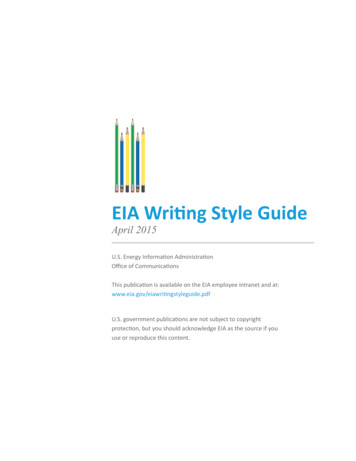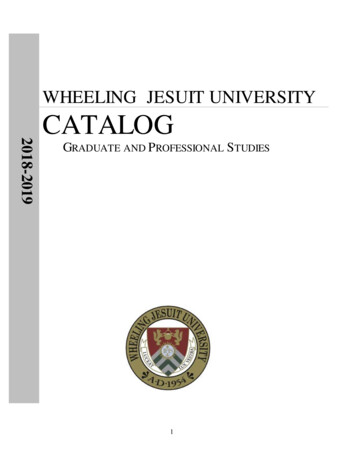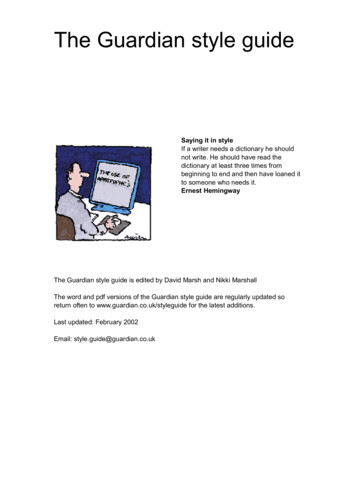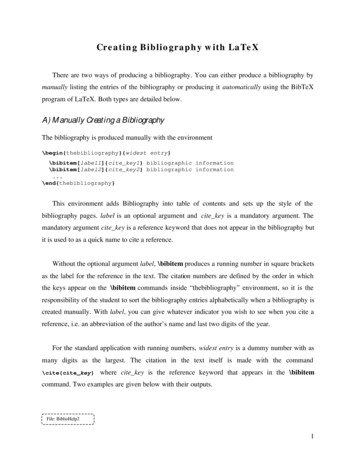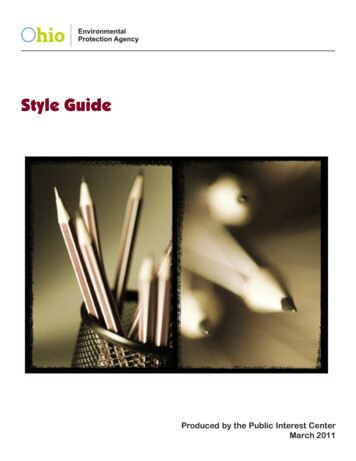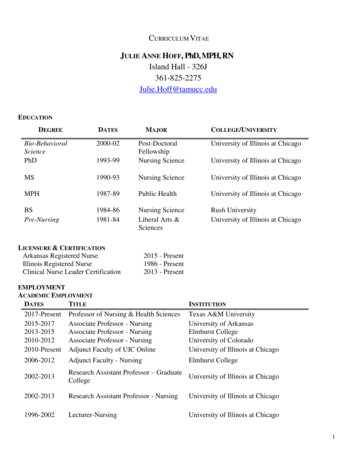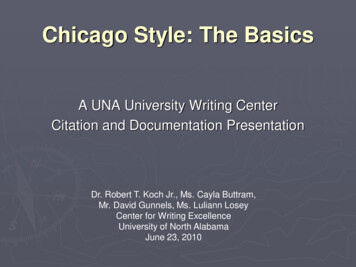
Transcription
Chicago Style: The BasicsA UNA University Writing CenterCitation and Documentation PresentationDr. Robert T. Koch Jr., Ms. Cayla Buttram,Mr. David Gunnels, Ms. Luliann LoseyCenter for Writing ExcellenceUniversity of North AlabamaJune 23, 2010
Today’s Goals Learn what Chicago style is, what it includes, and why it isimportantLearn about the standard Chicago title page formatLearn basic documentation for books, journals, andwebsitesLearn the differences between methods of sourceintegration: summarizing, paraphrasing, and quotingLearn how to use signal phrases and in-text notes to avoidplagiarism
What is Chicago Style? Why Use It?The Chicago Manual of Style, also called “Turabian Style” Style established in 1937 when Kate L. Turabianassembled a guideline for students at the University ofChicago Style provides guidelines for publication in some of thesocial sciences and natural & physical sciences, but mostcommonly in the humanities—literature, history, and thearts Style lends consistency and makes texts more readable bythose who assess or publish them p. xi & xiii Turabian 7Turabian, K.ate. A Manual for Writers of Research Papers, Theses, and Dissertations. (7th ed.). Chicago: University of Chicago Press., 2007
Chicago Style Chicago has two recommended styles or subtypes. Parenthetical citations-Reference List Notes-Bibliography The most common is Notes-Bibliography and this styleuses either footnotes or endnotes Footnotes, the most common, are printed at the bottom of the page Endnotes are a collected list at the end of the paper This style also includes a Bibliography page at the end of the paperthat lists all references in a format similar to the footnotes foundwithin the paperp. xi, 136, 141-142 Turabian 7Turabian, K.ate A Manual for Writers of Research Papers, Theses, and Dissertations. (7th ed.). Chicago: University of Chicago Press., 2007.
A Chicago Title Page Title(First-Third of the Page) Place the title here in all caps. If there is a subtitle, placea colon at the end of the main title and start the subtitleon the next line. NOT DOUBLE SPACED. Nameand Class Identification (Second-Third ofthe Page) Author(s) Name(s) Course Number and Title (ex. EN 099: Basic Writing) Date (Month date, year format)p. 378 & 386 Turabian 7
p. 378 & 386 Turabian 7A Chicago Title PageTurabian, K. A Manual for Writers of Research Papers, Theses, and Dissertations. (7th ed.). Chicago: University of Chicago Press, 2007.
Chicago Body Pages BodyPages in Chicago Style simply showthe page number in the top right corner. The prose of the paper is typically doublespaced (unless specified otherwise by yourprofessor) though block quotes are typedwith single spacing. Footnotes are entered at the bottom of thepage to show reference.p. 393 Turabian 7Turabian, K. A Manual for Writers of Research Papers, Theses, and Dissertations. (7th ed.). Chicago: University of Chicago Press, 2007.
Chicago Body Pagesp. 393 Turabian 7Turabian, K. A Manual for Writers of Research Papers, Theses, and Dissertations. (7th ed.). Chicago: University of Chicago Press, 2007.
Documentation Refersto the Bibliography list at the end ofthe paper The List is labeled Bibliography (centered, no font changes, only on the firstpage) starts at the top of a new page continues page numbering from the last page of text is alphabetical is single spaced with two blank lines between the title and the firstentry and one blank line between entries Uses a hanging indent (1/2 inch – can be formatted from theParagraph dialog box in MS Word)p. 404 & 401 Turabian 7Turabian, K. A Manual for Writers of Research Papers, Theses, and Dissertations. (7th ed.). Chicago: University of Chicago Press, 2007.
Documenting AuthorsIn the bibliography page. List the first author’s name in inverted order(Last name, First name), place a comma, and list each following authorin standard order (First Name Last Name). In the Note, list each authors’ name in standard order. No matter how many authors are listed within a work, every authormust be listed in the Bibliography page. The foot note, however, liststhe first author’s name in standard order followed by “et al.” for a workwith with four or more authors. Example Kenobi, Obi-wan, Quentin Jinn, Marc Windu, Kermit Mundi, PhilKoon, Kevin Fisto, Aaliyah Secura, Orville Rancisis, LucretiaUnduli, The Jedi Way. Coruscant: Coruscant Publishing, 1977.p. 163 and 230 Turabian 7Turabian, K. A Manual for Writers of Research Papers, Theses, and Dissertations. (7th ed.). Chicago: University of Chicago Press, 2007.
Documenting BooksModel for Bibliography:Author 1’s Last Name, First Name and Author 2’s First and Last Name,etc., Title of Book: Subtitle of Book. City: Publisher, Date of Publication.Model for Note:Note Number. Author 1’s First and Last Name and Author 2’s First andLast Name, Title of Book: Subtitle of Book. (City: Publisher, Date ofPublication), p#.Example of Note:3. Ash Williams and Raymond Knowby, The Powers of That Book.(Wilmington, North Carolina: Necronohaus Books, 1987), 22-25.p. 143 – 145 Turabian 7Turabian, K. A Manual for Writers of Research Papers, Theses, and Dissertations. (7th ed.). Chicago: University of Chicago Press, 2007.
Documenting Chapters in anEdited CollectionModel for Bibliography:Author 1’s Last Name, First Name, “Title of Article/Chapter.” In Title ofBook, edited by Editor’s First and Last Names, ##-##. City: Publisher,Date of Publication.Model for Note:Note Number. Author’s First and Last Names, “Title of Article/Chapter,” inTitle of Book, ed. Editor’s First and Last Names (City: Publisher, Dateof Publication), ##-##.Sample for Note:6. John McClain, “Broken Glass,” In Trials of Bare Feet, Ed. Al Powell(Los Angeles, California: 1988), 22-28.p. 144 - 145 Turabian 7Turabian, K. A Manual for Writers of Research Papers, Theses, and Dissertations. (7th ed.). Chicago: University of Chicago Press, 2007.
Documenting JournalsModel for Bibliography:Author 1’s Last Name, First Name. “Title of Article.” Title of Periodicalvolume, number (Date of Publication): XX-XX.Model for Note:Note Number. Author 1’s First and Last Names, “Title of Article,” Title ofPeriodical volume, number (Date of Publication): XX-XX.Sample of Note:1. Robert Koch Jr., “Building Connections Through Reflective Writing,”Academic Exchange Quarterly 10, no. 3 (2006): 208-213.p. 145 Turabian 7Turabian, K. A Manual for Writers of Research Papers, Theses, and Dissertations. (7th ed.). Chicago: University of Chicago Press, 2007.
Documenting Online JournalsModel for Bibliography:Author’s Last name, Author’s First Name. “Title of Article,” Title of JournalVolume, Number (Date of Publication). URL (accessed Date of Access).Model for Note:Note Number. Author’s First and Last Names, “Title of Article: Subtitle,”Title of Periodical Volume, Number (Date of Publication), under“Descriptive Locator or Subheading,” URL (accessed Date of Access).Sample of Note: 1. Minnie Mouse, “My Disney Success Beginning in 1950,” Life of DisneyQuarterly 10, no. 7 (2001), under ifeofdisney (accessed May 2, 2010).p. 145 Turabian 7Turabian, K. A Manual for Writers of Research Papers, Theses, and Dissertations. (7th ed.). Chicago: University of Chicago Press, 2007.
Documenting WebsitesBibliography Model for an authored website:Author Last Name, Author First Name. “Title of Page.” Title of Owner of the Site.URL (accessed Date of Access).Note Model for an authored website:Note Number. Author’s First and Last Names, “Title of the Page,” Title of Owner ofthe Site, URL (accessed Date of Access).Sample for Note:8. John Daniels, “Nebraska School Children Honored Teacher,” Nebraska FamilyCouncil, www.nebraskafictionnews.com/teacherhonored (January 18, 2007).No Author? Give the name of the owner of the site. Include as many elements ofthe citation as you can.p. 198 Turabian 7Turabian, K. A Manual for Writers of Research Papers, Theses, and Dissertations. (7th ed.). Chicago: University of Chicago Press, 2007.
Why Source Integration? Quotations, paraphrases, and summaries provide support for claims or add credibility to your writingrefer to work that leads up to the work you are now doinggive examples of several points of view on a subjectcall attention to a position that you wish to agree or disagree withhighlight a particularly striking phrase, sentence, or passage byquoting the original distance yourself from the original by quoting it in order to cuereaders that the words are not your own expand the breadth or depth of your writingp. 169 - 170 APA 6Quoting, paraphrasing, and summarizing. (2004). Purdue University Online Writing Lab. Retrieved September 28, 2007, h/r quotprsum.html
Choosing Text to Integrate1.2.3.4.Read the entire text, noting the key points andmain ideas.Summarize in your own words what the singlemain idea of the essay is.Paraphrase important supporting points thatcome up in the essay.Consider any words, phrases, or brief passagesthat you believe should be quoted directly.p. 169 - 170 APA 6Quoting, paraphrasing, and summarizing. (2004). Purdue University Online Writing Lab. Retrieved September 28, 2007, h/r quotprsum.html
Summarizing Whenyou summarize, you put the mainidea(s) into your own words, including onlythe main point(s). Summarized ideas must be attributed to theoriginal source. Summaries are significantly shorter than theoriginal. Summaries take a broad overview of sourcematerial.p. 170 - 174 APA 6Quoting, paraphrasing, and summarizing. (2004). Purdue University Online Writing Lab. Retrieved September 28, 2007, from http://owl.english.purdue.edu/handouts/research/r quotprsum.html
Paraphrasing Paraphrasinginvolves putting a passagefrom source material into your own words. Attribute paraphrases to their original sources. Paraphrases are usually shorter than, but maybe the same length as the original passage. Paraphrases take a more focused segment ofthe source and condense it slightly.p. 170 - 174 APA 6Quoting, paraphrasing, and summarizing. (2004). Purdue University Online Writing Lab. Retrieved September 28, 2007, h/r quotprsum.html
Quoting Quotationsmust be identical to the original. Quotations use a narrow segment of the source. They must match the source document word for wordand must be attributed to the original author. Use quotes when the actual words are so integral to thediscussion that they cannot be replaced. Use quotes when the author’s words are so preciselyand accurately stated that they cannot be paraphrased.p. 170 - 174 APA 6Quoting, paraphrasing, and summarizing. (2004). Purdue University Online Writing Lab. Retrieved September 28, 2007, h/r quotprsum.html
Using Footnotes in Text When using Chicago footnotes, whenever a source is usedin a paper, a footnote is inserted to credit the source.Footnotes are shown in text as superscript numbers thatrelate to a numbered source at the bottom of the page.The source at the bottom of the page includes much, if notall, of the original bibliographic source informationA simple rule: Who, What, Where, When, Which (pages)Authors’ First and Last Names, “Title” Title ofPeriodical, Owner, or Publisher (Date ofPublication): XX-XX (( page range))Turabian, K. A Manual for Writers of Research Papers, Theses, and Dissertations. (7th ed.). Chicago: University of Chicago Press, 2007.
Using Footnotes in Text(continued) Toenter a footnote (in Microsoft Word), place thecursor at the end of the sentence (after the period)that includes information or ideas from a source.Click “References” and click “Insert Foot Note” This inserts the superscript number and allowsyou to insert the corresponding source material atthe bottom of the page with the matched number The order the subscript and citations follow is theorder they appear in the textDocumenting sources at SNHU: APA style. (n.d.). Southern New Hampshire University. Retrieved September 17, 2007 fromhttp://acadweb.snhu.edu/documenting paraphraseTurabian, K. A Manual for Writers of Research Papers, Theses, and Dissertations. (7th ed.). Chicago: University of Chicago Press, 2007.
Using Footnotes in Text(continued) Inthe first in-text citation note, do the full citation. Ifthe same text is cited again, the note can beshortened to include Author Last Name, Title, andPage numbers:5. Johns, Nature of the Book, 384-85p. 136, 141-142 Turabian 7Documenting sources at SNHU: APA style. (n.d.). Southern New Hampshire University. Retrieved September 17, 2007 fromhttp://acadweb.snhu.edu/documenting paraphraseTurabian, K. (2007). A Manual for Writers of Research Papers, Theses, and Dissertations. (7th ed.). Chicago: University of Chicago Press.
References“Documenting sources at SNHU: APA style.” Southern New Hampshire University.http://acadweb.snhu.edu/documenting paraphrase“Quoting, paraphrasing, and summarizing.” Purdue University Online Writing Lab, ch/r quotprsum.htmlTurabian, Kate. A Manual for Writers of Research Papers, Theses, and Dissertations. 7th ed. Chicago:University of Chicago Press, 2007.University of Chicago. The Chicago Manual of Style: The Essential Guide for Writers, Editors, andPublishers. 15th ed. Chicago: University of Chicago Press, 2003.
A Manual for Writers of Research Papers, Theses, and Dissertations. (7th ed.). Chicago: University of Chicago Press, 2007. Documenting Websites Bibliography Model for an authored website: Author Last Name, Author
